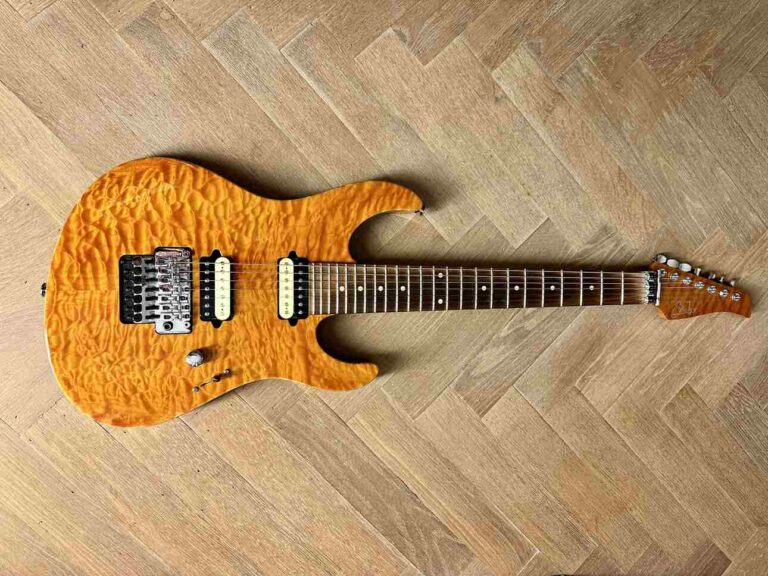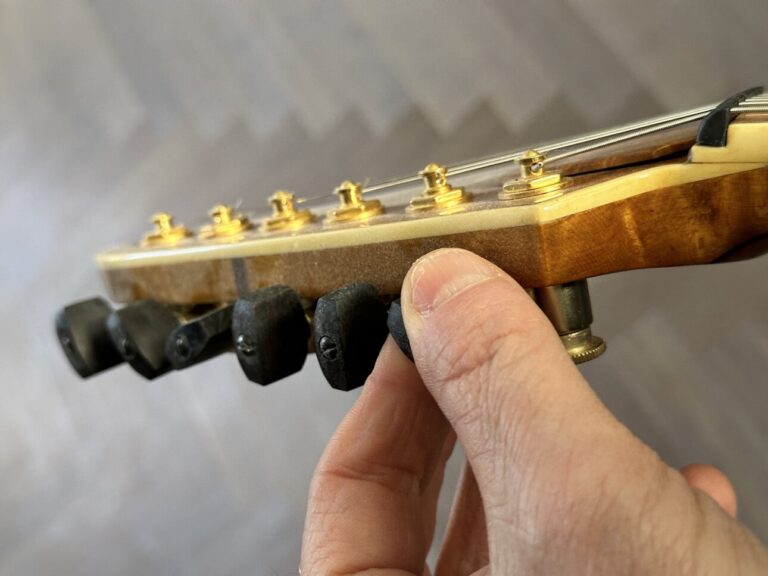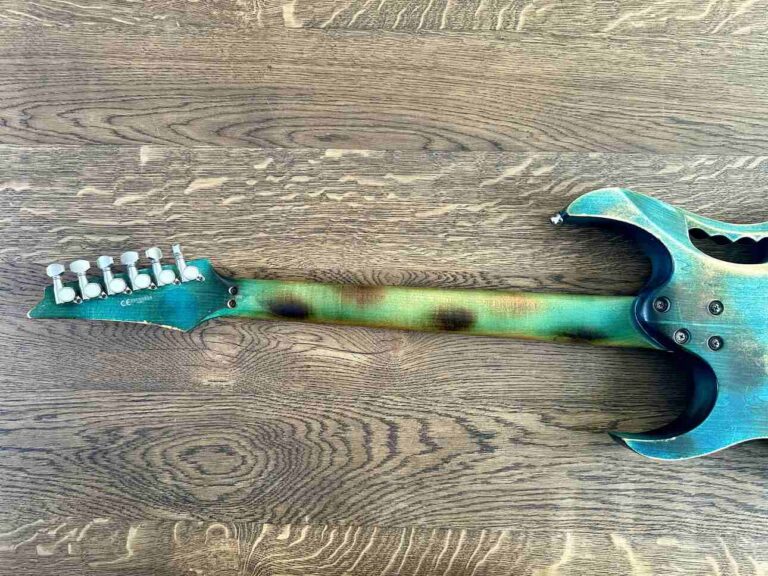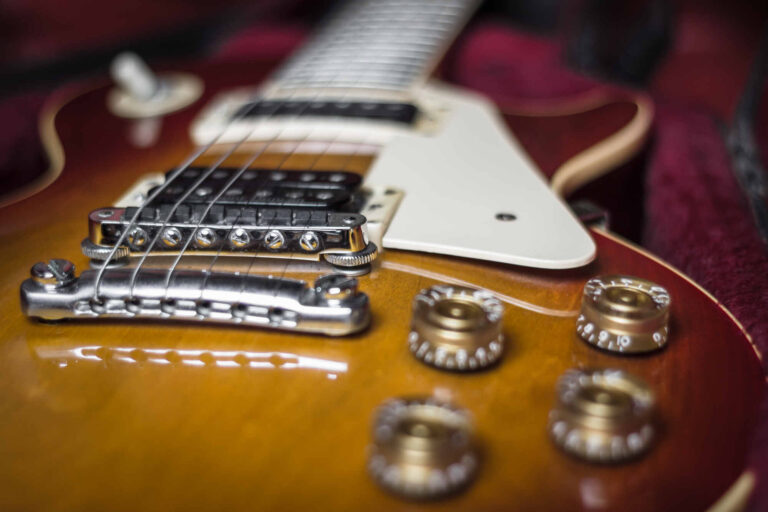How Long is a Guitar? Understanding Guitar Sizes Made Easy
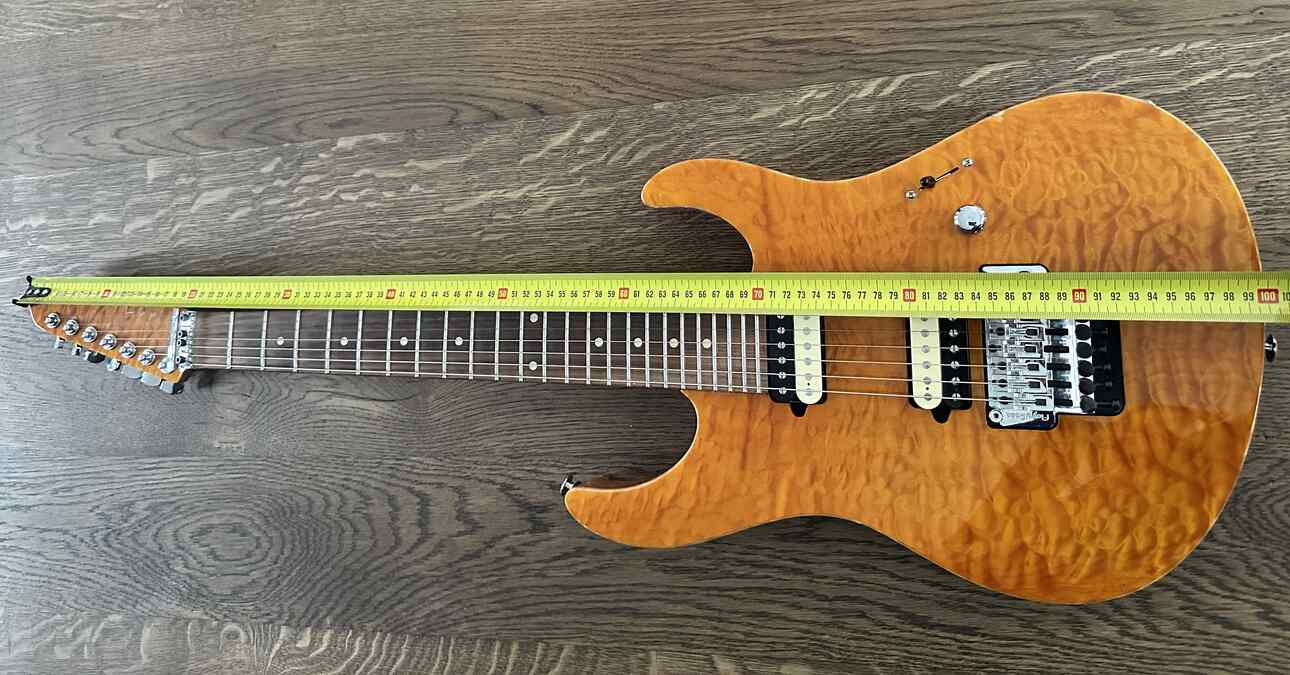
Ever wondered about the length of a guitar? If you’re a casual player or just dipping your toes into the world of six strings, knowing the size of your instrument can be as crucial as the tunes you play.
Guitars come in various shapes and sizes, each with its own vibe. From the compact travel guitar perfect for a road trip jam to the jumbo guitar that booms like thunder, size matters. But let’s not beat around the bush— how long is a guitar?
Generally speaking, a full-size guitar measures around 40 inches (101.6 centimeters) from the top of the headstock to the bottom of the body.
Smaller guitars, such as a parlor and three-quarter size models, can be significantly shorter.
Key Takeaways
- Guitars vary in length. Full sizes run about 38 inches (96.52 centimeters);
- Smaller ones – parlor, three-quarter – come shorter;
- Guitar sizes matter for comfort, playability, and the fit in your hands.
Fundamentals Of Guitar Size
Overview Of Guitar Types
You’ve got your acoustics, big and hollow, echoing sound for songs under the stars. They go by dreadnought, parlor and jumbo.
Then, the electrics. They’re a bit smaller, solid, and they come alive with amps and current. Models? Think Stratocaster, Telecaster and Les Paul.
Each one’s different. Each one feels different. Each one has its own sound and feel.
Understanding Guitar Scale Length
The length of a guitar has everything to do with scale length. It’s the measure from the nut to the bridge. And it’s the heart of a guitar’s size.
It decides the pull of the strings and the gap between frets. And that’s why it shapes how the guitar feels and plays.
Longer scales tighten strings and stretch frets apart. Shorter ones are easier on the fingers, as the frets are closer together.
Take acoustics. They span 24 to 25.5 inches (60.96 to 64.77 centimeters).
Electrics – like a Gibson – sit at 24.75 (62.87 centimeters) or at 25.5 (64.77 centimeters), like a Fender.
Choosing The Right Guitar Size
Full-Size Guitars
Full-size guitars are the standard. They’re built for adults and, let’s say, older teens. They come in many forms and many styles. But they share this: a scale around 25.5 inches (64.77 centimeters) and a total length near 38 inches (96,52 centimeters).
But here’s the thing: choose one that fits, that feels right in your hands. That’s the key.
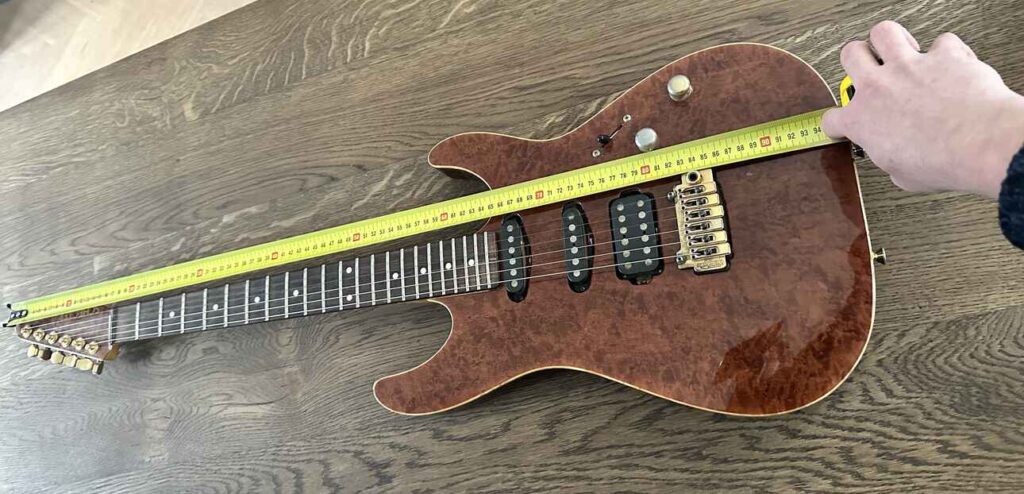
Short Scale Guitars
If the big guitars don’t fit your hands, short-scale actually might. They’re snug at about 24 inches (60,96 centimeters). As they’re smaller than the full sizes, they’re good for small hands, if you like them light and easy to hold.
Folks like Ed Sheeran pick short scales for the ease of moving around. If a full-size feels like too much, try a short-scale. It might be just right.
Just know that with acoustics, this might go at the cost of the sound as they usually also have a smaller body.
Children’s Guitars
For young players, the right size guitar is key. Smaller guitars fit smaller hands, making playing easier for kids. Match the guitar to the child’s age and height.
In general, a 3/4 size suits 8 to 11-year-olds well. A 1/2 size is right for 5 to 8-year-olds.
Don’t rush into big guitars. Too big can mean too hard, which can take the joy out of learning.
Guitar Size Variations
Acoustic Guitar Sizes
Acoustic guitars come in many sizes. They fit different hands and different styles.
Here’s how they line up:
- Parlor guitar: It’s the smallest of the lot. It’s good for finger picking, for soft tunes. They’re close, about 36-39 inches;
- Dreadnought acoustic: It’s chosen by many for its size and its deep voice. It stretches 40-42 inches (101.6-106,68 centimeters);
- Jumbo guitar: It’s the biggest. It’s loud and deep and can stand up to 44 inches (111,76 centimeters).
Electric Guitar Size Differences
Electric guitars are generally more uniform than acoustic guitars. Most run between 38-42 inches (96.52-106.68 centimeters). But even then, some play differently and feel different.
Look at the Fender Stratocaster, about 38 inches (96,52 centimeters), or the Gibson Les Paul, a bit more at 40 inches (101,6 centimeters). Each has its own style and fit for the player’s wish.
Note that this difference in size has to do with their respective scale lengths. A Gibson Les Paul’s neck is shorter than a Fender Stratocaster’s.
Baritone Electric Guitars
Step into the deeper waters of guitar land, and you’ll meet the baritone electric. It’s a different breed, with a scale length running from 27 to 30.5 inches (68.6 to 77.5 centimeters). These guitars pack a punch in the lower frequencies
Why pick up a baritone? Imagine beefing up your sound, diving deep into your tunes, all without the slack-stringed flop. The baritone keeps those low strings tight, gives you a sound that’s rich where standard guitars might falter.
If you like the low-end – metalheads and jazz cats – a baritone’s a solid choice. It’s got a sound that cuts through the usual mix.
But it’s not all smooth playing. That extra length stretches your fingers, and if you’re cozy with a standard electric, it’s a leap. Bending strings is tougher.
A baritone won’t fit every gig, but for that low-end rumble it shifts the game.
Bass Guitar Dimensions
Bass guitars are longer than other guitars, like acoustics and electrics. Full-sized ones range from 44 to 47 inches (111.76 to 119.38 centimeters).
But there’s room for the not-so-long, short-scale basses. They’re built for smaller hands, for comfort. They make playing bass reachable for more folks.
Measuring Guitar Size

To know a guitar’s length, look at two things: scale length, the stretch from nut to bridge, and overall length, end to end of the guitar. We’ll walk through both to grasp the full size of the instrument.
Measuring Scale Length
The scale length is the span from the nut to the bridge – the part of the string that vibrates when played. It shapes how the guitar feels and the pull of the strings.
To measure it:
1. Find the nut, the place where the headstock meets the fretboard;
2. Measure from there to the 12th fret, the halfway point;
3. Double that number for the full scale.
Acoustics often sit at 25.5 inches (64.77 centimeters), electrics between 24.75 and 25.5 inches (62.87 and 64.77 centimeters).
Measuring Overall Length
To find a guitar’s total length, measure from the headstock’s top down to the body’s bottom edge. Lay it flat, and run a tape measure straight down.
The length changes with the guitar’s type and style.
Here’s what they average:
- Dreadnought: 41 inches (104.14 centimeters)
- Parlor: 37 inches (93.98 centimeters)
- Classical: 38 inches (96.52 centimeters)
- Electric: 38 to 40 inches (96.52 to 101.6 centimeters)
Impact Of Size On Playability
Comfort And Handling
Size shapes the feel of a guitar. A big one might sound full but be challenging for the small, the young. A small guitar, though, fits well, is easy to play, and is a friend to beginners and the small-handed.
For the best fit, consider these:
- Body size: A small body is suitable for sitting and for learning. Big bodies give a rich sound in acoustic guitars;
- Neck width: Slim necks ease chord fretting. Wide necks make picking slightly easier;
- Scale length: Short scales are gentler, as the strings require less tension, and the frets are closer together.
Electric guitars are generally more uniform than acoustic guitars.
Most run between 38-42 inches (96.52-106.68 centimeters)
Sound Implications
Choosing a guitar size is about the sound, too. With acousitic guitars, big guitars boom deep and full. Small ones are more likely to sound bright and sharp.
Here are a few pointers:
- Body shape: Dreadnoughts and jumbos provide a booming bass. In contrast, concert and auditorium guitars give a balanced, versatile sound;
- Wood type: Wood changes the tone as they emphasize different frequencies. Pick the wood that sings your song.
Guitar Buying Guide
Size Considerations
When picking a guitar, size is key. A usual guitar is around 40 inches (101,6 centimeters). But there are sizes to fit you better.
Here’s a quick look:
- 3/4 size (36 inches / 91.44 centimeters): Good for the young, for small hands;
- 7/8 size (38 inches / 96,52 centimeters): Bigger than 3/4, yet not full-sized;
- Full size (40 inches / 101,6 centimeters): The go-to for adults.
No matter your years or skill, the right feel in your hands matters. It makes playing better and practice easier.
Guitar Brands And Models
There’s an overwhelming number of guitar brands to choose from. Some popular ones are:
- Fender
- Gibson
- Martin
- Taylor
- Epiphone
- Ibanez
- ESP
- Cort
- Jackson
- Charvel
- Suhr
It’s wise to try different guitars, even within one brand. Variety abounds. And price isn’t always the measure of quality. A less costly guitar often matches the expensive one in sound and playability.
Frequently Asked Questions
What are the dimensions of a full-size guitar?
A full-size guitar, often a dreadnought, spans about 41 inches (104.14 centimeters) and has a scale length of 25.5 inches (64.77 centimeters). Width and depth can vary across models.
Can you tell me the length of an acoustic guitar?
Acoustic guitar lengths run from 35 to 43 inches (88.9 to 109.22 centimeters), with the exact size depending on the guitar type – classical, parlor, or dreadnought – and the model.
How is the length of a guitar neck measured?
Measure from the nut to the 12th fret, then double it. This gives the scale length and the vibrating string’s reach.
What size guitar should adults typically use?
Adults usually go for full-size guitars like dreadnoughts, classicals or regular electric guitars, which fit most adult hands and offer diverse play styles.
Which guitar size is suitable for different ages?
Pick a guitar size that matches the player’s size—1/4 size for ages 4-6, 1/2 size for 6-9, 3/4 size for 9-12, and full size for 12 and up. Comfort is key.
How do the lengths of 3/4 and 39-inch guitars compare?
A 3/4 guitar is about 36 inches (91.44 centimeters) long, while a 39-inch (99.06 centimeters) guitar is slightly larger. Both are good for children or for a compact option.

